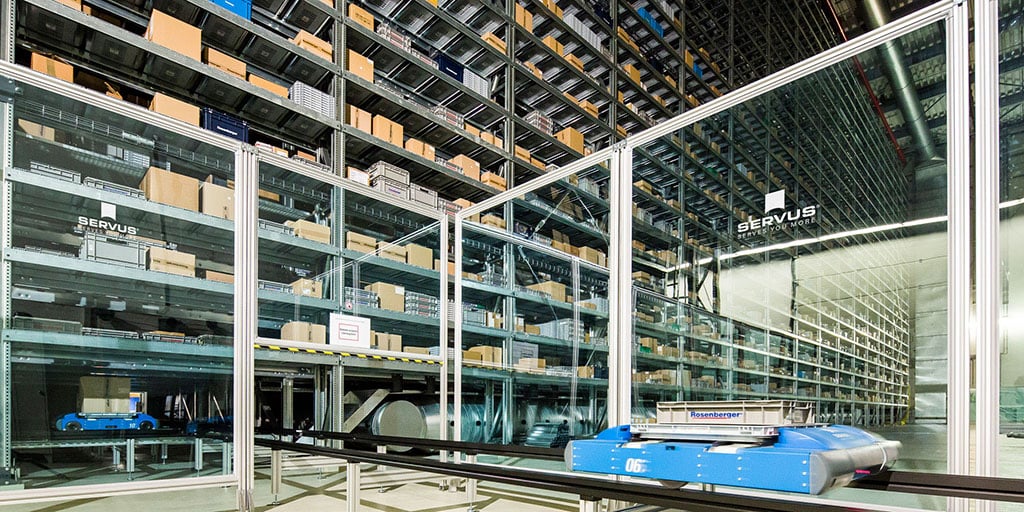Integrating Warehouses into the Process Flows to Be Ready for the Future
Once, there was a time when warehouse and production areas were as strictly separated as two kingdoms. They worked side by side. Push was practised instead of pull. Warehouses were considered island solutions. Though this is still often the case today, it is no longer the state of the art. Today, an automated storage and retrieval system (ASRS) should be fully integrated into the process flows. It should be a buffer for production. An ASRS is to supply production directly and with the right material at the right time. This has many benefits for the customers:
-
Faster throughput in production
-
Circulating stocks are reduced
-
Standing times in production and waiting times are a thing of the past
-
Fewer interfaces
-
Search times are removed
-
Quality in the processes increases and errors are reduced
-
All data are available in real time
Finally, this ensures that warehouse and production are in perfect alignment. The warehouse can be kept as small as possible but remains as large as necessary. “After all, the best warehouse is the warehouse you don’t have”.
However, this requires highly efficient work in the ASRS without any downtimes. Highest process safety must be ensured. Failure of individual aisles or levels, or even total failure of the automated storage and retrieval system (ASRS) must be avoided at all costs.

Unnecessary interfaces should be eliminated, and production should be supplied with the same transport system if at all possible, in order to integrate the warehouse into the process flow.
High Speed in Reprocurement
The example of our customer Phonak shows what a warehouse fully integrated into the process flows means for the customer. A specialist for high-quality hearing aids, it has its production site in Stäfa near Zürich. The Servus system is responsible for all transports along the entire value-added chain. The robotic carriers from Servus receive the goods at goods receipt, take them to the warehouse, to picking and to the right place in production at the right time. Phonak had its warehouse fully integrated into the process flows. This ensures the shortest access times. The lack of interfaces and the connected continuity of data transfers enormously increases the throughput speed at Phonak: When a hearing aid is sold in a shop in New York and scanned at checkout, this automatically trips a new production order for the hearing aid type in Stäfa. Our robotic carriers get going - without any manual order, without any additional work step, fully automated.
Only a customised warehouse that lives up to customer needs can be integrated into the process flow to become a breathing buffer.
The Warehouse as a Breathing Buffer
Beyond this, an ASRS must be viewed as a breathing buffer now more than ever. In times where batch sizes have reached 1 and same-day delivery is required, items no longer spend weeks in the warehouse. Each customer has individual demands. Is the warehouse meant for quick or slow-moving goods? What cycle times are needed? Should supermarkets be integrated? How much space is available? Where should the warehouse best be placed? How many items are to be stored? Providers must have the matching answers to all these questions today. They need solutions ready at hand and have close contact with customers.
Only a customised warehouse that lives up to customer needs can be integrated into the process flow to become a breathing buffer. When logistics and production merge into a unit, the tracks are set for lean logistics and the networked factory of tomorrow.
The picking strategy and picking technology should be customised at all times, too. Pick-by-Scan, Pick-by-Light, Pick-by-Vision and many other methods provide near-unlimited options. It is necessary to work closely with the customer in order to specifically handle customer’s wishes and to develop and implement just the right picking solution.
Another question is whether central picking stations should be implemented in connection with a central warehouse, or whether local picking units with associated buffer warehouses - where picking takes place where the materials are actually needed - would be better.
Flexibility must be observed as well. In spite of all automation, ASRSs must be easily expansible in capacity and scalable on demand in their performance. Only this way can a company remain fit for the future and react dynamically to market developments.
There are many questions to be answered when introducing a new warehouse system. An intense focus on material flows is unavoidable to develop the best solution together with the customer.
Current trends and information on intralogistics can be found in the new SERVUS Whitepaper:
.jpg)
About the author
Wolfgang Brändle is Product and plant designer at Servus Intralogistics

